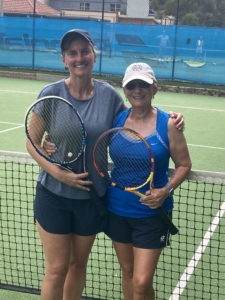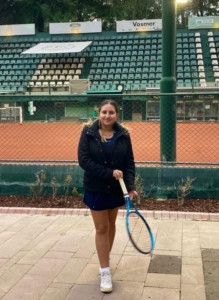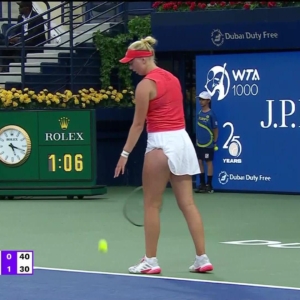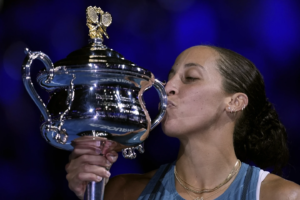New Senior Pro Tennis Tours
/in Goss, NewsThe Challenge of Longevity in Tennis & Soccer
/in Goss, NewsThe Challenge of Longevity in Elite Sports
Elite athletes in sports like soccer and tennis push their bodies to the limit season after season, facing relentless schedules, high-intensity competition, and mounting injury risks. With minimal recovery time and rising expectations, the challenge is no longer just about reaching peak performance—it’s about sustaining it over a long career.
- Soccer players endure congested fixture calendars, often playing 60+ matches per season, leading to muscle and tendon injuries due to insufficient structured training.
- Tennis professionals face a year-round season with no true off-season, battling overuse injuries and mental fatigue while constantly traveling.
As both sports continue to evolve in speed and intensity, longevity now depends on cutting-edge training adaptations, personalized recovery strategies, and psychological resilience.
So, how can modern athletes extend their careers while preserving their physical health and mental well-being?
Coping with a Relentless Schedule
Both professional tennis and soccer place extreme physical and mental demands on athletes due to their packed competition schedules. While these sports differ in structure—tennis as an individual, year-round sport and soccer as a team-based league format—they share similar challenges in managing fatigue, preventing injuries, and optimizing performance.
1. Match Overload and Limited Recovery
- Soccer: Top players compete in domestic leagues, international tournaments, and European competitions, playing every 3-4 days with minimal time for proper training.
- Tennis: Professionals play 80+ matches per season, covering ATP/WTA events, Grand Slams, Davis Cup/Billie Jean King Cup, and exhibition matches, with no true off-season.
✅ Common Challenge: High match volume leads to muscle fatigue, overuse injuries, and burnout, requiring careful workload management.
2. Injury Risks and Physiological Toll
- Soccer: Players cover 10-12 km per match, with a high percentage of sprints and high-intensity movements, leading to hamstring strains, ACL tears, and tendon issues.
- Tennis: The sport’s repetitive movements cause chronic overuse injuries in the shoulder, wrist, and knees, along with stress fractures and muscle strains from sudden directional changes.
✅ Common Challenge: Both sports demand explosive speed, agility, and endurance, making conditioning and injury prevention crucial for career longevity.
3. Training Adaptations
- Soccer: Teams use “micro-dosing” strength training, focusing on low-intensity, frequent exercises over traditional weightlifting. Recovery includes sports massages, ice baths, and hydration protocols.
- Tennis: Players prioritize active recovery, physiotherapy, and functional strength training, emphasizing core stability, flexibility, and movement efficiency.
✅ Common Strategy: Both sports rely on sports science and individualized training plans to balance recovery, injury prevention, and sustained performance.
4. Performance Monitoring and Technology
- Soccer: Clubs use AI-driven injury prediction, GPS tracking, biomechanics analysis, and blood tests to monitor muscle fatigue and immune response.
- Tennis: Players rely on wearable technology, heart rate variability tracking, and video analysis to assess movement efficiency and workload.
✅ Common Approach: Real-time data analysis, biomechanics, and sports science help athletes optimize performance and avoid injuries.
5. Mental Fatigue and Burnout
- Soccer: Constant travel, high-pressure matches, and lack of extended breaks lead to mental fatigue and stress, prompting early retirements (e.g., Raphaël Varane).
- Tennis: The nonstop season and psychological demands cause mental exhaustion, contributing to early retirements (e.g., Ashleigh Barty).
✅ Common Challenge: Psychological resilience is key. Strategies like mindfulness, visualization, and mental conditioning help players maintain focus and avoid burnout.
Final Thoughts: The Key to Longevity in Elite Sports
Both soccer and tennis demand:
- Peak physical fitness
- Quick recovery
- Strategic workload management
While soccer players contend with a congested fixture calendar, tennis professionals must navigate a year-long season with no real downtime.
The key to longevity lies in smart recovery, scientific training adaptations, and mental resilience. As athletes continue pushing their bodies to the limit, finding sustainable solutions for performance and recovery will define how long they stay at the top.
Why This Matters for Athletes and Coaches
✅ Understanding sports science, injury prevention, and mental conditioning can prolong careers.
✅ Implementing smarter training and recovery strategies can enhance long-term performance.
✅ Monitoring workload and psychological well-being is just as critical as physical fitness.
As the demands of elite sports evolve, staying at the top requires more than talent—it demands a strategy for longevity.
Vale, Fred Stolle
/in Goss, NewsVale, Fred Stolle
The tennis world bids farewell to Australian great Fred Stolle, who has passed away at the age of 86. A pivotal figure in the golden era of Australian tennis during the 1960s, Stolle made an immense impact both as a player and later as a respected commentator.
A Fierce Competitor and Grand Slam Champion
Nicknamed “Fiery Fred,” Stolle was known for his relentless drive and competitive spirit. He reached five Grand Slam singles finals before finally breaking through in 1965 at the French Championships, defeating fellow Australian Tony Roche on clay—his least preferred surface.
A year later, he captured the U.S. Championships title at Forest Hills, overcoming John Newcombe in an all-Australian final. This victory saw him rise to the world No. 1 ranking before turning professional.
A Doubles Icon
While his singles achievements were impressive, Stolle’s dominance in doubles was unparalleled. He won 17 Grand Slam doubles titles, securing all four major championships in his career. His partnerships with Roy Emerson, Bob Hewitt, and Ken Rosewall helped define an era where Australia was at the pinnacle of world tennis.
Additionally, Stolle won seven mixed doubles Grand Slams, playing alongside legends such as Margaret Court and Lesley Turner Bowrey.
Davis Cup Heroics
Stolle played a crucial role in Australia’s Davis Cup triumphs in 1964, 1965, and 1966. His unforgettable five-set victories in high-stakes matches showcased his resilience and ability to perform under immense pressure.
In 1964, with Australia trailing 2-1 against the United States, Stolle’s five-set win over Dennis Ralston kept his country’s hopes alive. The following year, he led the charge in Sydney, defeating Spain’s Manolo Santana in another grueling battle.
A Mentor and Commentator
After retiring from professional play, Stolle transitioned into coaching, guiding Vitas Gerulaitis to the 1977 Australian Open title. His deep knowledge of the game and sharp tactical mind also made him a sought-after television commentator.
His insightful analysis and engaging storytelling helped educate and entertain generations of tennis fans worldwide.
A Personal Memory
I had the pleasure of playing against Fred several times and often caught up with him in the U.S. when he was playing in World Team Tennis.
The last time I saw him was several years ago at the Manly Golf Club. A friend of mine, eager to meet him, asked for an introduction. Gracious as ever, Fred came over and spent 15 minutes in gentle conversation, sharing stories and making my mate feel as if they had known each other for years.
That was Fred—humble, kind, and always generous with his time.
A Lasting Legacy
Fred Stolle’s impact on tennis goes beyond titles and trophies. His dedication, sportsmanship, and contributions to the game as a player, coach, and commentator have left an enduring mark.
He is survived by his wife Pat, his son Sandon—a U.S. Open doubles champion—and his daughters Monique and Nadine.
Rest in peace, Fred Stolle.
Congratulations to Sofie & Pam
/in Goss, News, Tournaments2025 Combined 100 Ladies Club Champions! 🏆
A big congratulations to Sofie and Pam on their impressive victory in the Combined 100 Ladies Club Championship today at Manly Lawn Tennis Club!
Their skill, teamwork, and determination were on full display as they battled through tough competition to claim the title.
💪 A Display of Dedication and Teamwork
Throughout the event, Sofie and Pam showcased exceptional court coverage, strategic play, and resilience under pressure. Their win is a testament to their hard work and commitment to the game. All those Sunday practices paid off!
🎉 Time to Celebrate!
Well done, ladies! Your achievement is truly inspiring, and we hope you enjoy celebrating this special moment.

🏆 Final Results:
✅ Winners: Sofie & Pam
✅ Event: Combined 100 Ladies Club Championship
✅ Location: Manly Lawn Tennis Club
A Promising Debut on the International Stage
/in Goss, NewsManly’s Newest International Tennis Star: Deniz
Deniz made a successful debut in Turkiye, competing in her first international tournament. Before participating, she had to pass the official Turkiye tennis accreditation, which she accomplished with ease.
In her first event, Deniz reached the quarter-finals but fell short with a 3-6, 2-6 loss. Reflecting on her experience, she shared:
“I lost my quarter-final match 3-6, 2-6, but it was a good and fun experience. The nerves got to me, and I dropped a few games after leading 40-30 or 40-15. My serves felt solid overall, though I did hit a few double faults due to the nerves.”
This is just the beginning of what promises to be an exciting journey for Deniz. With a strong start on the international stage, there is plenty more to come!

Congratulations, Deniz—well done!
Tennis Growth Is Not Always Linear: Tauson’s Journey
/in Goss, NewsClara Tauson’s Breakthrough
Clara Tauson’s journey on the WTA Tour has been anything but linear, but her breakthrough run at the Dubai Duty Free Tennis Championships is proof that persistence pays off.
The 22-year-old Dane has battled injuries, setbacks, and the pressure of following in the footsteps of Caroline Wozniacki. Now, she’s making a statement of her own.
A Career-Defining Week in Dubai
- Defeated world No. 1 Aryna Sabalenka in straight sets
- Won a tense battle against former world No. 3 Elina Svitolina
- Came from behind to beat rising star Linda Noskova, saving a set point
- Now ranked in the world’s Top 30 for the first time
This deep run marks a turning point—six years after her 2019 Australian Open junior title.
Tennis Growth Is Not Always Linear
While Iga Swiatek and Coco Gauff turned junior success into Grand Slam titles, Tauson’s progress has been slower but steady.
She’s proving that success in tennis isn’t just about meteoric rises—it’s about endurance, adaptation, and persistence.
Similar to Madison Keys, who won her first Grand Slam at 29, Tauson is proving that patience is key.
What’s Changed? Coaching & Smart Training
- New Coach: Tauson is now working with Kasper Elsvad—her boyfriend and former hitting partner
- Stronger Backhand: A past weakness is now a reliable shot
- Improved Movement: Better footwork has helped reduce errors
- More Efficient Training: Shifted from long hours to short, high-intensity sessions to prevent injuries
“I was injured from quite a young age, but I hopefully still have many years left on the tour.” – Clara Tauson
Tauson’s Secret Weapon: The Serve
- Leads the WTA in aces for 2025
- First-serve points won:
- 2023: 65.2%
- 2024: 70.4%
- 2025: 73.3%
Against Sabalenka:
- Tauson landed 52% of first serves
- Won 80% of first-serve points—a huge efficiency leap
Her serve is no longer just powerful—it’s precise and effective.

MLTC Badge Teams Posted
/in Goss, NewsBadge 2025 Teams
The Manly Lawn Badge Teams have now been posted on the club website!
For easy access, copies of all teams, as well as the 2025 Badge Rules and Fact Sheets, can be found here: 👉 Manly Lawn Badge 2025
Get ready for an exciting season ahead!
Why Tennis and Pickleball Are Growing Together, Not Apart
/in Goss, NewsTennis vs. Pickleball
The rapid rise of pickleball, driven by its accessibility and ease of play, has led to frequent comparisons with tennis—a sport known for its rich traditions and demanding physicality.
With tennis legends like Andre Agassi and Steffi Graf embracing pickleball, the differences between these two racket sports—especially in terms of difficulty and appeal to different age groups—have become a hot topic.
Tennis: The “Mount Everest” of Racket Sports
Tennis is widely regarded as the most challenging racket sports due to its high physical, technical, and strategic demands. Agassi himself has referred to it as “Mount Everest,” requiring a combination of power, precision, movement, and mental toughness.
Key Factors That Make Tennis Difficult
- Footwork and Agility – Tennis players must develop explosive first steps, lateral movement, and quick transitions.
- Variety of Strokes – Success in tennis requires mastery of multiple strokes, including topspin, slice, volleys, and powerful serves.
- Physical Endurance – Matches can last for hours, requiring peak VO2 max and energy efficiency to maintain high performance.
- Strategic Complexity – Singles players rely on tactics like shot variation and exploiting weaknesses, while doubles players use formations like the I-Formation to gain an advantage.
Pickleball: The Accessible Alternative
In contrast, pickleball—especially in its doubles format—focuses more on control and reflexes than on physical strength and movement. This makes it easier to learn and more accessible, particularly for beginners or older players.
Key Characteristics of Pickleball
- Smaller Court, Less Running – Three or four pickleball courts can fit on a single tennis court, reducing the movement required.
- Slower Pace, Quick Reaction Time – Pickleball demands sharp reflexes but relies less on endurance and speed, making it ideal for seniors or those with physical limitations.
- Easier Skill Acquisition – Unlike tennis, which requires years of refining strokes, pickleball allows players to improve quickly, keeping them engaged.
- Lower Injury Risk – Tennis’ intense rotational movements can put stress on hips, knees, and shoulders, making long-term play challenging. Pickleball, however, is less punishing on the joints, as Agassi and Graf have pointed out.
Attractiveness to Players: Young vs. Old
Both sports offer unique appeals depending on the age and goals of the players.
For Younger Players
- Tennis – The prestige of professional tournaments and the challenge of high-level competition attract young athletes seeking excellence.
- Pickleball – Increasingly popular for its social and recreational aspects, though it lacks the grandeur of Grand Slam events.
For Older Players
- Tennis – While still an option, maintaining elite-level movement and footwork becomes increasingly difficult with age.
- Pickleball – Specifically designed to accommodate seniors and casual players, offering a competitive yet less physically demanding alternative.
Complementary, Not Competing
While some tensions exist over court space, tennis and pickleball are proving to be complementary rather than competing sports. Many tennis players transition to pickleball as they age, while some pickleball players use it as an introduction before moving into tennis.
Which Sport is Right for You?
✅ Tennis remains the ultimate test of skill, endurance, and mental toughness, perfect for those who thrive on challenge and competition.
✅ Pickleball is an accessible, social, and lower-impact alternative, ideal for those seeking longevity, fun, and community.
Regardless of which sport you choose, both offer great benefits and an enjoyable way to stay active—at any age!
Sinner’s Three-Month Doping Ban: A Controversial Resolution
/in Goss, NewsJannik Sinner Suspended for Three Months After Anti-Doping Violation
World No. 1 Jannik Sinner has officially accepted a three-month suspension from professional tennis following an anti-doping rule violation.
The 23-year-old Australian Open champion tested positive for clostebol, a banned anabolic steroid, during the Indian Wells Masters 1000 tournament in March 2024. While an Independent Tribunal (ITIA) ruled that Sinner bore “no fault or negligence”, the World Anti-Doping Agency (WADA) appealed the decision, seeking a harsher penalty.
Rather than facing a prolonged legal battle, Sinner and WADA reached a case resolution agreement under Article 10.8.2 of the WADA Code. His suspension runs until May 4, 2025, but he will be allowed to resume training on April 13.
Key Points of the Ban
✔ No Intent to Cheat – WADA acknowledged that Sinner had no intent to dope, nor did he gain any performance-enhancing advantage from clostebol.
✔ Negligence by His Team – The banned substance was accidentally transferred due to his physiotherapist’s use of a healing spray.
✔ Minimal Impact on Grand Slams – The suspension does not affect Sinner’s ability to compete in major tournaments, as he will return in time for the French Open and Italian Open.
✔ Loss of Indian Wells Points & Prize Money – While his Australian Open title remains intact, he has been stripped of ranking points and prize money from Indian Wells.
What’s Next for Sinner?
The timing of the suspension means that Sinner will miss key tournaments like Indian Wells and Miami, but he will return just in time for the clay-court season.
His expected comeback will be at the Italian Open, his home tournament, where he will prepare for Roland Garros and aim to regain momentum.
However, the ruling has sparked mixed reactions in the tennis world. Some believe WADA’s decision was fair, while others argue that Sinner received a lenient punishment, given the strict liability policy for banned substances.
Getting in the Zone: The Travis Kelce Playbook for Success
/in Ask the Pro, Goss, News, PsychologyGetting in the Zone: Inside the Mind of Chiefs Star Travis Kelce
Introduction
📌 Travis Kelce, the Kansas City Chiefs’ star tight end, is known for his unique approach to preparation and relentless dedication to the game. During practices, Kelce often isolates himself, mentally rehearsing plays and movements—a habit that his teammates and coaches recognize as integral to his success.
Despite his fame, including a high-profile relationship with Taylor Swift and numerous off-field opportunities, Kelce remains deeply committed to football and intends to continue playing at an elite level.
Applying Kelce’s Work Ethic to Tennis
Travis Kelce’s approach to football—his mental focus, relentless preparation, leadership, and longevity—translates well into competitive tennis. Here’s how tennis players can integrate his mindset and training habits into developing their own game:
📌 1. Mental Preparation: Visualizing & Practicing in Your Own Zone
✅ Shadow Swinging & Visualization – During downtime or warm-ups, practice cross-over steps, footwork patterns, and swing mechanics without the ball.
✅ Silent Rehearsals – Before matches, visualize different point scenarios (e.g., defending against a big server, executing a drop shot, or constructing a point on a slower surface).
✅ Between Points Reset – Use the time between points to refocus mentally, just as Kelce locks into his zone when waiting for the offense to take the field.
💪 2. Relentless Training & Competitive Edge
✅ Commit to Consistent Drills – Work on footwork patterns, agility, and stroke repetition—even when you’re not in full practice sessions.
✅ Embrace the Hard Days – If Kelce fights through fatigue in practice, tennis players should train through slight discomfort (e.g., continuing drills when mentally drained).
✅ Match Simulation in Practice – Create match-like intensity in training sessions so that match-day nerves don’t affect execution.
🎾 3. Leadership & Holding Others Accountable
✅ Doubles Leadership – In doubles play, communicate effectively, encourage your partner, and take responsibility for keeping team energy high.
✅ Being a Mentor – If you train with juniors or less experienced players, lead by example by keeping high intensity in practice.
✅ Setting the Standard – Just as Kelce refuses to let younger players coast, demand effort from yourself and training partners.
🏆 4. Staying Hungry Despite Success
✅ Avoid Complacency – Whether you’ve won a club tournament or reached a new ranking, immediately set new goals.
✅ Long-Term View – Like Kelce, focus on the longevity of your career by maintaining proper conditioning and avoiding burnout.
✅ Champion’s Mindset – Tennis legends like Novak Djokovic and Rafael Nadal mirror Kelce’s hunger—always finding ways to improve and never settling.
🔥 5. Handling High-Stress Moments
✅ Control Emotions – Channel frustration into positive intensity rather than letting it spiral into unforced errors.
✅ Use Pressure to Elevate Performance – Train to perform your best in tiebreaks, match points, and clutch situations.
✅ Psychological Resilience Drills – Implement routines like deep breathing, positive self-talk, and mindfulness to stay composed under pressure.
🩺 6. Physical Durability & Longevity
✅ Tennis-Specific Strength & Agility Training – Work on lower-body strength for explosive movement and upper-body endurance.
✅ Recovery & Injury Prevention – Incorporate stretching, yoga, hydration, and proper nutrition to extend your career.
✅ Footwork Mastery – Small prep steps, explosive first steps, and recovery steps are essential for maintaining an elite level.
💡 Final Thoughts
🎯 Just like Kelce, tennis players should strive to stay in their “own zone,” push boundaries, and refuse to settle for anything less than excellence.
Embrace the mental toughness, work ethic, and competitive drive that define Kelce’s career, and bring them onto the tennis court—because success is built through consistent effort, preparation, and an unshakable mindset.
The Australian Open’s Battle in the Grand Slam Arms Race
/in Goss, NewsHow the AO is navigating expansion pressures and keeping its competitive edge
Introduction
The Grand Slam arms race is in full swing. With the U.S. Open expanding to a 15-day event, and Wimbledon, Roland Garros, and the Australian Open (AO) constantly vying for supremacy, the competition for prestige, revenue, and global attention has never been more intense.
As each major seeks to evolve into a three-week tennis festival, the AO faces unique challenges, from financial pressures to extreme heat and scheduling conflicts. However, innovative strategies have allowed Melbourne’s slam to stay ahead.
Challenges Facing the Australian Open
✅ Financial Pressure & Rising Costs
- With Wimbledon and the U.S. Open generating $500 million annually, the AO must maximize revenue streams to keep pace.
- Increased prize money demands and operational costs require innovative financial strategies.
✅ Global Competition & Scheduling Conflicts
- Expanding the tournament footprint risks clashing with ATP/WTA tour events in February.
- Unlike European Slams, the AO must work harder to attract global audiences in January.
✅ Extreme Heat & Player Welfare
- AO’s summer conditions present a unique player welfare challenge compared to the other Slams.
- Heat management remains a logistical hurdle, requiring strategic scheduling.
✅ Infrastructure & Fan Engagement
- Unlike Wimbledon, which faces local opposition to expansion, AO has successfully redeveloped Melbourne Park.
- However, further growth in seating capacity and fan experience is necessary to maintain long-term competitiveness.
How AO is Responding
🟢 ‘Opening Week’ Success
The AO has expanded its festival experience without officially extending the main draw. In 2024, Opening Week attracted 117,000 fans—more than Roland Garros’ entire qualifying attendance.
🟢 World-Class Player Amenities
AO boasts the most advanced player facilities in Grand Slam history, including:
- Luxury lounges and sleeping pods
- State-of-the-art recovery zones
- Underground player complex for comfort and convenience
🟢 Enhanced Night Sessions & Digital Innovation
- Night matches are a hallmark of the AO, creating an unmatched atmosphere.
- Expanded digital fan engagement through VR experiences and immersive broadcasts keeps audiences connected globally.
🟢 Scheduling Flexibility & Heat Management
- Unlike Wimbledon’s 11 p.m. curfew, AO has more flexibility in scheduling.
- With three retractable-roof stadiums, it remains ahead of Roland Garros in handling weather disruptions.
The Future of AO in the Grand Slam Arms Race
While the AO has not officially moved to a 15-day format, its Opening Week success suggests a gradual transition. As attendance records continue to be shattered, further expansion may be inevitable.
Perseverance Personified: Maddy Keys’ Inspiring Journey
/in AO25, Goss, News, WhispererIf at First You Don’t Succeed, Try 16 Years
Madison Keys captured her first Grand Slam title in spectacular fashion, defeating Aryna Sabalenka 6-3, 2-6, 7-5 in a thrilling Australian Open final on Saturday at Melbourne Park.
In a high-stakes showdown between the No. 19 and No. 2 seeds, Keys emerged victorious after a match filled with rapid shifts in momentum. She dominated with exceptional serving in the first set, adjusted to an off-speed battle in the second, and demonstrated extraordinary composure in a dramatic final set where both players raised their level under intense pressure.
Success Delayed but Not Denied
Madison Keys’ story proves that greatness doesn’t always come easily—even for prodigies. At just 14, she was hailed as the future of tennis, celebrated for her raw power and potential. But it would take 16 years, countless setbacks, and a transformative shift in mindset to achieve her dream of winning a Grand Slam.
Her victory at the 2025 Australian Open stands as a testament to resilience, patience, and the power of self-belief.

Madison Keys’ Journey: A 16-Year Success
Early Days of Promise
Madison Keys burst onto the tennis scene as a teenage sensation, training under the guidance of Chris Evert. Her effortless power and fearless style of play quickly set her apart, with her first WTA victory coming at just 14.
“From 10 years old, she had more power than anyone her age. On a good day, she could beat anyone.” – Chris Evert
However, with early success came immense expectations. When she struggled to meet these lofty goals, doubts and setbacks began to creep in, creating a rollercoaster of highs and lows throughout her career.
Major Turning Points in Her Career
1. The Buzz of Early Success (2008-2017):
- As a teenager, Keys reached the Australian Open semifinals and later made the 2017 U.S. Open final. However, a nerve-wracked performance against Sloane Stephens saw her fall short.
- Mounting expectations created mental roadblocks and inconsistent performances.
2. Setbacks and Injury Struggles (2018-2022):
- Keys faced a series of injuries, including a devastating hamstring tear at Wimbledon 2022, that derailed her progress.
- Therapy and self-reflection helped her confront the fear of being labeled a failure, allowing her to redefine her goals and focus.
3. Redefining Success (2023-2025):
- Together with her coach and husband, Bjorn Fratangelo, Keys embraced a new mindset—playing courageously and without regrets, rather than striving for perfection.
- This shift led to her breakthrough, defeating three top-10 players (including World No. 1 Aryna Sabalenka) to claim the 2025 Australian Open title.
Lessons Learned Along the Way
1. Perseverance Pays Off
Madison Keys’ story demonstrates that persistence and patience are critical to success. It may take longer than expected, but the rewards are worth it.
2. Harnessing Strengths
Rather than holding back her natural power, Keys learned to amplify it, making her unique style of play her greatest asset.
3. Mental Growth
Therapy and a supportive environment helped her overcome the mental toll of high expectations, allowing her to play with confidence and freedom.
4. A Winning Mindset
Keys adopted a new mantra: success isn’t just about winning—it’s about playing with courage, conviction, and leaving the court with no regrets.
“If you consistently do the right things, success will follow—though it may take time!”
Madison Keys’ remarkable journey to her first Grand Slam title is a story of resilience, determination, and personal growth. Her 16-year quest reminds us all that great things are possible when you refuse to give up.
Best Day in Life of 7 Year Old
/in AO25, Goss, NewsNaomi Osaka 3.0: Strategies for Conquering a Competitive Slump
/in AO25, Goss, Psychology-
- At her favorite Grand Slam, Osaka defeated Caroline Garcia in the first round, a win that avenged her loss to Garcia at the same tournament in 2024. This victory reflected her improved focus and determination.
- In the second round, she faced rising star Karolina Muchova and battled back from a tough first set to win 1-6, 6-1, 6-3. This win highlighted Osaka’s ability to adapt under pressure, demonstrating her signature power game and tactical precision.
Muchova, the No. 20 seed in Melbourne, is a rising star with a versatile all-court game that has become essential at the highest levels of women’s tennis. While Osaka’s powerful baseline attack has defined her success, it had previously struggled to counter Muchova’s craftiness. At the U.S. Open in August, Muchova’s sharp slices and well-timed volleys proved too much for Osaka, sending her packing early from New York. “She crushed me when I had my best outfit ever,” Osaka said on court. “She’s one of the best players out there.”
-
- Osaka’s performance against Muchova showed her capacity to control rallies, dictate points, and deliver under high-pressure moments. Her deep backhands and precise serves forced her opponent out of position, a testament to her renewed confidence and physical readiness.
Key Lessons from Her Comeback:
-
Adapt and Trust Your Strengths:
- Osaka’s ability to adjust mid-match and commit to her powerful baseline game is a reminder to trust your natural strengths, even when facing adversity.
-
Mental Resilience:
- Osaka openly shared her struggles with focus and overthinking but emphasized self-belief and positive self-talk as key strategies. Her ability to clear her mind and deliver in critical moments serves as a blueprint for mental toughness.
-
Set Realistic Goals:
- Setting purposeful milestones, such as returning to a top-32 ranking, kept Osaka motivated and gave her a clear focus for her comeback journey.
-
Leverage Support Systems:
- With a new accomplished coach like Patrick Mouratoglou by her side, Osaka highlighted the importance of expert guidance and tactical insights to overcome challenges.
Takeaways for Players Facing a Slump:
- Resilience and Adaptability: Use setbacks as opportunities to refine your game and grow as a player.
- Focus on Strengths: Trust in your best assets and stay aggressive during critical points.
- Mental Strategies: Use visualization, mindfulness, and positive self-talk to build composure and confidence.
- Celebrate Progress: Set achievable goals and take pride in incremental victories.
- Stay Tactical: Lean on expert coaching and strategic planning to elevate your game.

Recent News
- Choosing a New Racket: Feel First, Specs Second
- 2025 NCAA Singles Champs: Brantmeier and Zheng
- Playing Singles: The Art of Talking to Yourself
- Alcaraz and Sinner Masterclass: Learning from Losses
- Young Guns Breakthrough Win in Club Championships
- Mobility Is What Matters
- From Wood to Wisdom: 50 Years of Tennis Evolution
- Tennis Thrives on Contrasting Styles
- Rybakina’s Masterclass: How to Beat the Big Banger
- Club Championships: Men’s Semifinals

